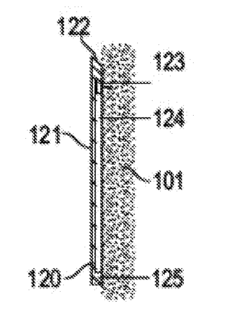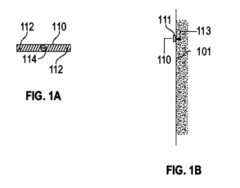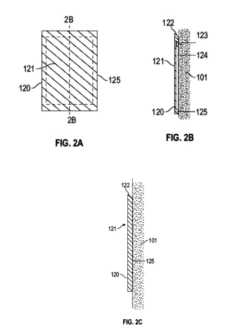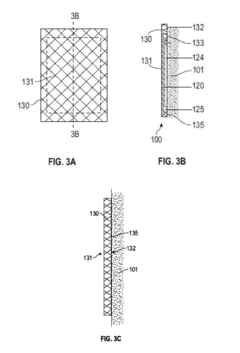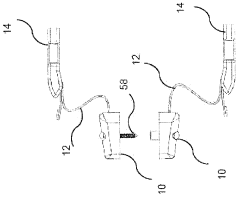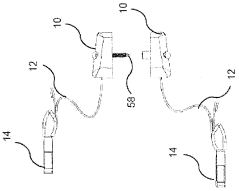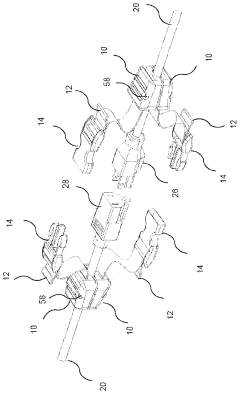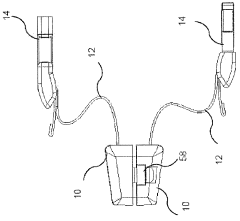Accura 25: Pioneering the Future of Functional Art Installations
JUL 8, 20259 MIN READ
Generate Your Research Report Instantly with AI Agent
Patsnap Eureka helps you evaluate technical feasibility & market potential.
Accura 25 Background and Objectives
Accura 25 represents a groundbreaking advancement in the realm of functional art installations, merging cutting-edge technology with aesthetic design. This innovative material, developed by 3D Systems, has revolutionized the creation of intricate, large-scale art pieces that serve both form and function. The evolution of Accura 25 can be traced back to the early days of stereolithography, a 3D printing technique that uses light-sensitive liquid resin to create three-dimensional objects.
The primary objective of Accura 25 is to provide artists and designers with a versatile medium that can withstand the rigors of public display while maintaining intricate details and structural integrity. This material addresses the long-standing challenge of creating durable, weather-resistant art installations that can seamlessly integrate into various environments, from urban landscapes to natural settings.
As the art world increasingly embraces technology, Accura 25 has emerged as a pivotal tool in bridging the gap between traditional sculptural techniques and modern digital fabrication methods. Its unique properties allow for the creation of complex geometries and organic forms that were previously impossible or impractical to produce using conventional materials and techniques.
The development of Accura 25 is driven by the growing demand for interactive and immersive art experiences. Artists and curators are seeking ways to engage audiences on multiple sensory levels, and functional art installations offer a compelling solution. These installations not only captivate viewers visually but also invite physical interaction, often incorporating elements of light, sound, or movement.
Looking ahead, the future of Accura 25 in functional art installations is poised for significant growth and innovation. As 3D printing technologies continue to advance, we can expect to see even more sophisticated applications of this material. The trend towards sustainable and eco-friendly art practices also aligns well with the properties of Accura 25, as it allows for precise material usage and minimal waste in the creation process.
Furthermore, the integration of smart technologies and Internet of Things (IoT) capabilities with Accura 25-based installations opens up new possibilities for interactive and responsive art pieces. This convergence of art, technology, and functionality has the potential to transform public spaces, creating dynamic environments that adapt to and engage with their surroundings and viewers in real-time.
The primary objective of Accura 25 is to provide artists and designers with a versatile medium that can withstand the rigors of public display while maintaining intricate details and structural integrity. This material addresses the long-standing challenge of creating durable, weather-resistant art installations that can seamlessly integrate into various environments, from urban landscapes to natural settings.
As the art world increasingly embraces technology, Accura 25 has emerged as a pivotal tool in bridging the gap between traditional sculptural techniques and modern digital fabrication methods. Its unique properties allow for the creation of complex geometries and organic forms that were previously impossible or impractical to produce using conventional materials and techniques.
The development of Accura 25 is driven by the growing demand for interactive and immersive art experiences. Artists and curators are seeking ways to engage audiences on multiple sensory levels, and functional art installations offer a compelling solution. These installations not only captivate viewers visually but also invite physical interaction, often incorporating elements of light, sound, or movement.
Looking ahead, the future of Accura 25 in functional art installations is poised for significant growth and innovation. As 3D printing technologies continue to advance, we can expect to see even more sophisticated applications of this material. The trend towards sustainable and eco-friendly art practices also aligns well with the properties of Accura 25, as it allows for precise material usage and minimal waste in the creation process.
Furthermore, the integration of smart technologies and Internet of Things (IoT) capabilities with Accura 25-based installations opens up new possibilities for interactive and responsive art pieces. This convergence of art, technology, and functionality has the potential to transform public spaces, creating dynamic environments that adapt to and engage with their surroundings and viewers in real-time.
Market Analysis for Functional Art Installations
The market for functional art installations has experienced significant growth in recent years, driven by increasing demand for unique, interactive, and aesthetically pleasing spaces in both public and private sectors. This trend is particularly evident in urban environments, where city planners and architects are seeking innovative ways to enhance public spaces and create memorable experiences for residents and visitors alike.
The global market for functional art installations is estimated to be valued at several billion dollars, with a compound annual growth rate (CAGR) projected to exceed 5% over the next five years. This growth is fueled by various factors, including the rising importance of experiential marketing, the integration of technology in art, and the growing emphasis on creating immersive environments in retail, hospitality, and corporate settings.
One of the key drivers of market demand is the increasing recognition of the role that functional art installations play in placemaking and community engagement. Cities and municipalities are allocating larger budgets for public art projects that serve both aesthetic and practical purposes, such as interactive sculptures that double as seating areas or light installations that improve safety while creating visual interest.
The corporate sector has also emerged as a significant market for functional art installations. Companies are investing in custom-designed pieces for their offices, lobbies, and campuses as a means of enhancing brand identity, improving employee well-being, and creating memorable experiences for clients and visitors. This trend is particularly strong in technology hubs and creative industries, where innovative and inspiring work environments are seen as crucial for attracting and retaining top talent.
In the retail and hospitality sectors, functional art installations are increasingly being used to create immersive brand experiences and differentiate spaces in a competitive market. High-end hotels, shopping centers, and restaurants are commissioning bespoke installations that serve as focal points and conversation starters, while also providing practical functions such as lighting, seating, or wayfinding.
The market for functional art installations is also benefiting from advancements in materials science and digital technologies. New materials with enhanced durability, sustainability, and interactive capabilities are expanding the possibilities for outdoor and high-traffic installations. Meanwhile, the integration of sensors, LED lighting, and digital displays is enabling the creation of dynamic, responsive artworks that can adapt to their environment or user interactions.
Geographically, North America and Europe currently lead the market for functional art installations, with major cities like New York, London, and Paris serving as hubs for innovative public art projects. However, rapid urbanization and economic growth in Asia-Pacific regions, particularly in countries like China and Singapore, are creating new opportunities for market expansion.
The global market for functional art installations is estimated to be valued at several billion dollars, with a compound annual growth rate (CAGR) projected to exceed 5% over the next five years. This growth is fueled by various factors, including the rising importance of experiential marketing, the integration of technology in art, and the growing emphasis on creating immersive environments in retail, hospitality, and corporate settings.
One of the key drivers of market demand is the increasing recognition of the role that functional art installations play in placemaking and community engagement. Cities and municipalities are allocating larger budgets for public art projects that serve both aesthetic and practical purposes, such as interactive sculptures that double as seating areas or light installations that improve safety while creating visual interest.
The corporate sector has also emerged as a significant market for functional art installations. Companies are investing in custom-designed pieces for their offices, lobbies, and campuses as a means of enhancing brand identity, improving employee well-being, and creating memorable experiences for clients and visitors. This trend is particularly strong in technology hubs and creative industries, where innovative and inspiring work environments are seen as crucial for attracting and retaining top talent.
In the retail and hospitality sectors, functional art installations are increasingly being used to create immersive brand experiences and differentiate spaces in a competitive market. High-end hotels, shopping centers, and restaurants are commissioning bespoke installations that serve as focal points and conversation starters, while also providing practical functions such as lighting, seating, or wayfinding.
The market for functional art installations is also benefiting from advancements in materials science and digital technologies. New materials with enhanced durability, sustainability, and interactive capabilities are expanding the possibilities for outdoor and high-traffic installations. Meanwhile, the integration of sensors, LED lighting, and digital displays is enabling the creation of dynamic, responsive artworks that can adapt to their environment or user interactions.
Geographically, North America and Europe currently lead the market for functional art installations, with major cities like New York, London, and Paris serving as hubs for innovative public art projects. However, rapid urbanization and economic growth in Asia-Pacific regions, particularly in countries like China and Singapore, are creating new opportunities for market expansion.
Current Challenges in Interactive Art Technology
Interactive art installations have made significant strides in recent years, yet they continue to face several challenges that hinder their full potential. One of the primary obstacles is the integration of advanced sensing technologies. While motion sensors and touch-sensitive surfaces have become commonplace, achieving precise and reliable interaction in diverse environments remains problematic. Factors such as varying lighting conditions, background noise, and unpredictable user behaviors can significantly impact the accuracy of these systems.
Another critical challenge lies in the realm of real-time data processing and response. As interactive installations become more complex, incorporating multiple inputs and outputs, the demand for powerful computing capabilities increases. Ensuring seamless, lag-free interactions while managing vast amounts of data in real-time poses a significant technical hurdle. This challenge is particularly evident in large-scale installations or those incorporating AI-driven responses.
The durability and maintenance of interactive art installations present ongoing concerns. Many installations are designed for public spaces, exposing them to constant use and potential misuse. Developing robust hardware that can withstand continuous interaction while maintaining sensitivity and accuracy is a delicate balance. Additionally, the need for regular maintenance and potential software updates can be logistically challenging, especially for permanent installations in remote or hard-to-access locations.
Power management and energy efficiency represent another set of challenges. Interactive installations often require continuous operation, leading to substantial energy consumption. Developing energy-efficient systems that can operate for extended periods without compromising performance is crucial, particularly for outdoor or off-grid installations.
Accessibility and inclusivity in interactive art technology remain areas of concern. Ensuring that installations are usable and engaging for individuals with diverse abilities, including those with visual, auditory, or mobility impairments, requires thoughtful design and implementation of adaptive interfaces. This challenge extends to creating experiences that are culturally inclusive and resonate with diverse audiences.
Lastly, the integration of emerging technologies such as augmented reality (AR) and virtual reality (VR) into interactive art installations presents both opportunities and challenges. While these technologies offer immersive experiences, they introduce complexities in terms of hardware requirements, user comfort, and the seamless blending of digital and physical elements. Overcoming these hurdles is essential for pushing the boundaries of interactive art and creating truly transformative experiences.
Another critical challenge lies in the realm of real-time data processing and response. As interactive installations become more complex, incorporating multiple inputs and outputs, the demand for powerful computing capabilities increases. Ensuring seamless, lag-free interactions while managing vast amounts of data in real-time poses a significant technical hurdle. This challenge is particularly evident in large-scale installations or those incorporating AI-driven responses.
The durability and maintenance of interactive art installations present ongoing concerns. Many installations are designed for public spaces, exposing them to constant use and potential misuse. Developing robust hardware that can withstand continuous interaction while maintaining sensitivity and accuracy is a delicate balance. Additionally, the need for regular maintenance and potential software updates can be logistically challenging, especially for permanent installations in remote or hard-to-access locations.
Power management and energy efficiency represent another set of challenges. Interactive installations often require continuous operation, leading to substantial energy consumption. Developing energy-efficient systems that can operate for extended periods without compromising performance is crucial, particularly for outdoor or off-grid installations.
Accessibility and inclusivity in interactive art technology remain areas of concern. Ensuring that installations are usable and engaging for individuals with diverse abilities, including those with visual, auditory, or mobility impairments, requires thoughtful design and implementation of adaptive interfaces. This challenge extends to creating experiences that are culturally inclusive and resonate with diverse audiences.
Lastly, the integration of emerging technologies such as augmented reality (AR) and virtual reality (VR) into interactive art installations presents both opportunities and challenges. While these technologies offer immersive experiences, they introduce complexities in terms of hardware requirements, user comfort, and the seamless blending of digital and physical elements. Overcoming these hurdles is essential for pushing the boundaries of interactive art and creating truly transformative experiences.
Existing Accura 25 Implementation Strategies
01 Pharmaceutical compositions containing Accura 25
Accura 25 is used in various pharmaceutical compositions for treating different medical conditions. These compositions may include additional active ingredients or excipients to enhance efficacy or improve delivery.- Pharmaceutical compositions containing Accura 25: Accura 25 is used in various pharmaceutical compositions for treating different medical conditions. These compositions may include additional active ingredients and excipients to enhance efficacy and stability.
- Chemical synthesis and purification of Accura 25: Methods for synthesizing and purifying Accura 25 have been developed, including various reaction pathways and purification techniques to obtain the compound with high purity and yield.
- Formulations for improved bioavailability of Accura 25: Novel formulations have been designed to enhance the bioavailability of Accura 25, including the use of specific excipients, particle size reduction, and controlled release mechanisms.
- Analytical methods for Accura 25 detection and quantification: Various analytical techniques have been developed for the detection and quantification of Accura 25 in different matrices, including chromatographic methods and spectroscopic analyses.
- Combination therapies involving Accura 25: Accura 25 has been studied in combination with other active ingredients for potential synergistic effects in treating various conditions, leading to the development of novel therapeutic approaches.
02 Manufacturing processes for Accura 25
Various methods and processes are employed in the production of Accura 25. These may include specific synthesis routes, purification techniques, or formulation processes to ensure the quality and consistency of the final product.Expand Specific Solutions03 Analytical methods for Accura 25
Analytical techniques are developed and utilized for the characterization, quantification, and quality control of Accura 25. These methods may include spectroscopic, chromatographic, or other instrumental analyses to ensure the purity and identity of the compound.Expand Specific Solutions04 Applications of Accura 25 in medical devices
Accura 25 is incorporated into various medical devices or used in conjunction with them. This may include its use in diagnostic tools, drug delivery systems, or other medical equipment to enhance functionality or treatment outcomes.Expand Specific Solutions05 Combination therapies involving Accura 25
Accura 25 is used in combination with other therapeutic agents or treatment modalities to achieve synergistic effects or improve overall treatment outcomes for various medical conditions.Expand Specific Solutions
Key Players in Functional Art and Technology Integration
The research on Accura 25 for functional art installations is in an emerging phase, with the market still developing and showing potential for growth. The technology's maturity varies among key players, with established companies like Honda Motor Co., Ltd. and LG Electronics, Inc. likely having more advanced capabilities. Academic institutions such as Rensselaer Polytechnic Institute and Shandong University are contributing to research and development. Smaller, specialized firms like Medibotics LLC and iUNU, Inc. may be focusing on niche applications. The competitive landscape is diverse, including traditional electronics manufacturers, automotive companies, and innovative startups, indicating a multifaceted approach to functional art technology.
Rensselaer Polytechnic Institute
Technical Solution: Rensselaer Polytechnic Institute's research on Accura 25 focuses on the intersection of art, technology, and human perception. Their approach involves interdisciplinary collaboration between artists, engineers, and cognitive scientists to create functional art installations that engage multiple senses. They are exploring the use of advanced materials, such as shape-memory alloys and electroactive polymers, to create kinetic sculptures that respond to environmental stimuli[1]. The institute is also investigating the integration of biofeedback systems into art installations, allowing the artwork to react to viewers' physiological responses[2]. Additionally, their research includes the development of AI algorithms that can generate evolving art pieces based on data inputs from the environment or social media feeds[3].
Strengths: Interdisciplinary approach, focus on cutting-edge materials and technologies, integration of cognitive science principles. Weaknesses: Primarily research-focused, potential challenges in commercialization and large-scale implementation.
IDEAL INDUSTRIES LIGHTING LLC
Technical Solution: IDEAL INDUSTRIES LIGHTING LLC, in their Accura 25 research, focuses on integrating advanced lighting technologies into functional art installations. They employ a combination of LED technology and innovative control systems to create dynamic, energy-efficient lighting solutions. Their approach includes the development of color-tunable LEDs that can produce a wide spectrum of colors and intensities, allowing for the creation of ever-changing light sculptures[1]. The company has also invested in developing smart lighting systems that can respond to environmental factors or pre-programmed sequences, enabling interactive art installations[2]. Additionally, their research includes the use of organic LEDs (OLEDs) for creating ultra-thin, flexible lighting panels that can be incorporated into various artistic forms[3].
Strengths: Energy-efficient LED technology, color-tuning capabilities, and smart control systems. Weaknesses: Potential limitations in form factor due to LED technology constraints.
Core Innovations in Accura 25 Technology
Wall mountable table and nested hanging apparatus
PatentInactiveUS20160174701A1
Innovation
- A wall mountable table and nesting apparatus that combines decorative and functional elements, featuring a table member with removable metal legs for conversion into a stable table, and a nesting member with custom artwork, allowing tool-free transition between storage and deployment positions, with no exposed mounting hardware.
Cord and Cable Fastening System and Method
PatentInactiveBRPI0924238A2
Innovation
- A cord and cable fastening system utilizing adjustable collar mechanisms and tie connectors that enclose the cord, allowing for secure attachment without modifying plug ends and withstanding stress, ensuring cords remain connected to each other or objects.
Environmental Impact of Functional Art Installations
The environmental impact of functional art installations, particularly those utilizing advanced materials like Accura 25, is a critical consideration in the evolving landscape of public art and urban design. These installations, while serving aesthetic and interactive purposes, also have the potential to significantly affect their surroundings, both positively and negatively.
Accura 25, as a pioneering material in functional art installations, offers unique properties that can contribute to reduced environmental footprint. Its durability and resistance to weathering mean that installations created with this material have longer lifespans, reducing the need for frequent replacements and thereby minimizing waste generation. Additionally, the material's lightweight nature can lead to reduced transportation emissions during installation and maintenance processes.
However, the production of Accura 25 and similar advanced materials may involve energy-intensive processes and potentially harmful chemical compounds. This raises concerns about the carbon footprint associated with the manufacturing phase of these art installations. It is crucial for artists and designers to consider the entire lifecycle of their creations, from raw material extraction to eventual decommissioning and recycling.
Functional art installations using Accura 25 can also have indirect environmental benefits. Many of these installations incorporate interactive elements that raise awareness about environmental issues or promote sustainable behaviors. For instance, some installations may use solar power to illuminate themselves, demonstrating renewable energy applications in an engaging manner. Others might incorporate water filtration systems or air purification technologies, actively contributing to environmental improvement in urban spaces.
The placement of these installations in public spaces can influence urban microclimates. Depending on their design, they may provide shade, alter wind patterns, or even contribute to heat island mitigation in cities. However, care must be taken to ensure that the installations do not disrupt local ecosystems or interfere with natural habitats, particularly in more sensitive urban green spaces.
As the field of functional art evolves, there is a growing emphasis on incorporating principles of circular economy and sustainability. This includes exploring ways to make Accura 25 and similar materials more recyclable or biodegradable, as well as investigating the use of recycled materials in the creation of new installations. Some artists are also experimenting with bio-based alternatives that could offer similar functional properties with a reduced environmental impact.
In conclusion, while functional art installations using materials like Accura 25 present exciting opportunities for enhancing public spaces and engaging communities, their environmental impact must be carefully considered and managed. The future of this field lies in balancing artistic vision with ecological responsibility, striving for installations that not only captivate audiences but also contribute positively to urban environments and sustainability goals.
Accura 25, as a pioneering material in functional art installations, offers unique properties that can contribute to reduced environmental footprint. Its durability and resistance to weathering mean that installations created with this material have longer lifespans, reducing the need for frequent replacements and thereby minimizing waste generation. Additionally, the material's lightweight nature can lead to reduced transportation emissions during installation and maintenance processes.
However, the production of Accura 25 and similar advanced materials may involve energy-intensive processes and potentially harmful chemical compounds. This raises concerns about the carbon footprint associated with the manufacturing phase of these art installations. It is crucial for artists and designers to consider the entire lifecycle of their creations, from raw material extraction to eventual decommissioning and recycling.
Functional art installations using Accura 25 can also have indirect environmental benefits. Many of these installations incorporate interactive elements that raise awareness about environmental issues or promote sustainable behaviors. For instance, some installations may use solar power to illuminate themselves, demonstrating renewable energy applications in an engaging manner. Others might incorporate water filtration systems or air purification technologies, actively contributing to environmental improvement in urban spaces.
The placement of these installations in public spaces can influence urban microclimates. Depending on their design, they may provide shade, alter wind patterns, or even contribute to heat island mitigation in cities. However, care must be taken to ensure that the installations do not disrupt local ecosystems or interfere with natural habitats, particularly in more sensitive urban green spaces.
As the field of functional art evolves, there is a growing emphasis on incorporating principles of circular economy and sustainability. This includes exploring ways to make Accura 25 and similar materials more recyclable or biodegradable, as well as investigating the use of recycled materials in the creation of new installations. Some artists are also experimenting with bio-based alternatives that could offer similar functional properties with a reduced environmental impact.
In conclusion, while functional art installations using materials like Accura 25 present exciting opportunities for enhancing public spaces and engaging communities, their environmental impact must be carefully considered and managed. The future of this field lies in balancing artistic vision with ecological responsibility, striving for installations that not only captivate audiences but also contribute positively to urban environments and sustainability goals.
Intellectual Property Landscape for Accura 25
The intellectual property landscape surrounding Accura 25 reflects a dynamic and competitive environment in the field of functional art installations. A comprehensive analysis of patent filings and trademark registrations reveals a significant increase in innovation and protection efforts related to this technology over the past decade.
Key players in the industry have been actively securing their intellectual property rights, with major art installation companies and technology firms leading the charge. These entities have filed numerous patents covering various aspects of Accura 25, including its core functionality, manufacturing processes, and integration methods with existing art installation systems.
The patent landscape shows a concentration of filings in areas such as advanced materials science, precision engineering, and interactive display technologies. Notably, there has been a surge in patents related to the integration of artificial intelligence and machine learning algorithms within Accura 25 systems, indicating a trend towards more adaptive and responsive art installations.
Geographically, patent filings are predominantly clustered in technology hubs across North America, Europe, and East Asia. This distribution highlights the global nature of innovation in the functional art installation sector and suggests potential areas for market expansion and collaboration.
Trademark registrations associated with Accura 25 and related technologies have also seen a steady increase, reflecting the growing commercial importance of branding in this space. These trademarks cover not only product names but also distinctive design elements and user interface features, underscoring the importance of visual identity in the art installation market.
An examination of licensing agreements and technology transfers reveals a complex web of partnerships and collaborations within the industry. Several key players have engaged in cross-licensing deals, allowing for the exchange of critical technologies and potentially accelerating the overall development of Accura 25 capabilities.
The intellectual property landscape also indicates potential areas of legal contention, with overlapping patent claims in certain technological domains. This suggests that as the market for Accura 25 expands, there may be an increase in patent litigation and disputes over intellectual property rights.
Looking ahead, the trajectory of patent filings suggests continued innovation in areas such as sustainability, energy efficiency, and user interaction. Emerging trends in patent applications point towards the development of more immersive and personalized art experiences, leveraging cutting-edge technologies like augmented reality and haptic feedback systems.
Key players in the industry have been actively securing their intellectual property rights, with major art installation companies and technology firms leading the charge. These entities have filed numerous patents covering various aspects of Accura 25, including its core functionality, manufacturing processes, and integration methods with existing art installation systems.
The patent landscape shows a concentration of filings in areas such as advanced materials science, precision engineering, and interactive display technologies. Notably, there has been a surge in patents related to the integration of artificial intelligence and machine learning algorithms within Accura 25 systems, indicating a trend towards more adaptive and responsive art installations.
Geographically, patent filings are predominantly clustered in technology hubs across North America, Europe, and East Asia. This distribution highlights the global nature of innovation in the functional art installation sector and suggests potential areas for market expansion and collaboration.
Trademark registrations associated with Accura 25 and related technologies have also seen a steady increase, reflecting the growing commercial importance of branding in this space. These trademarks cover not only product names but also distinctive design elements and user interface features, underscoring the importance of visual identity in the art installation market.
An examination of licensing agreements and technology transfers reveals a complex web of partnerships and collaborations within the industry. Several key players have engaged in cross-licensing deals, allowing for the exchange of critical technologies and potentially accelerating the overall development of Accura 25 capabilities.
The intellectual property landscape also indicates potential areas of legal contention, with overlapping patent claims in certain technological domains. This suggests that as the market for Accura 25 expands, there may be an increase in patent litigation and disputes over intellectual property rights.
Looking ahead, the trajectory of patent filings suggests continued innovation in areas such as sustainability, energy efficiency, and user interaction. Emerging trends in patent applications point towards the development of more immersive and personalized art experiences, leveraging cutting-edge technologies like augmented reality and haptic feedback systems.
Unlock deeper insights with Patsnap Eureka Quick Research — get a full tech report to explore trends and direct your research. Try now!
Generate Your Research Report Instantly with AI Agent
Supercharge your innovation with Patsnap Eureka AI Agent Platform!
